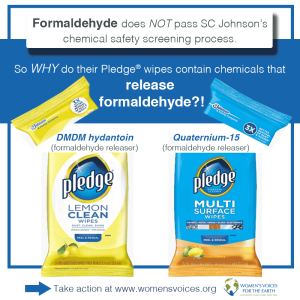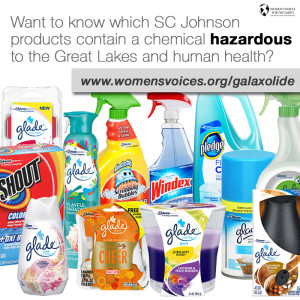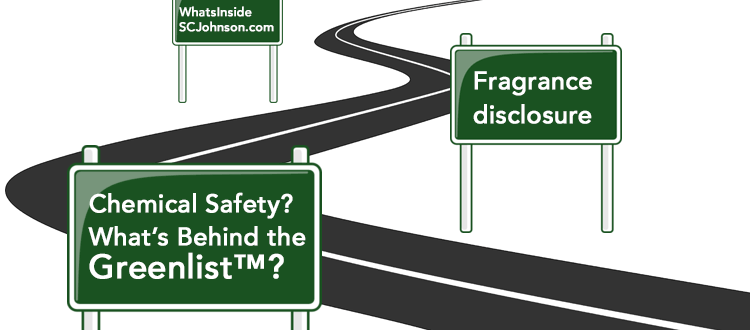SC Johnson’s Journey Along ‘Disclosure Road’
 |
| Sarada Tangirala National Campaigns Manager |
In 2007 WVE released its Household Hazards Report, the first-ever report to investigate toxic chemicals in household cleaning products. Ever since then, we have continued to move major cleaning product makers to disclose all ingredients in their products, including fragrance ingredients. With the release of our most recent report, Deep Clean, we are also looking for companies to make public how they screen chemicals for safety. Our campaign to get SC Johnson to “Deep Clean” its Greenlist™ and eliminate the fragrance ingredient Galaxolide are only the latest efforts to move the cleaning product giant to truly be an industry leader.
But this should in no way indicate that we feel SC Johnson is a laggard. They scored a B- (a fairly high score for a conventional company) on our Deep Clean scorecard for a reason. So let’s take a look at how far SCJ has come along this path we’re calling “Disclosure Road.”
Disclosure Road
As early as 2009, SCJ made a public commitment to disclose product ingredients, thanks to WVE’s campaign and to thousands of women raising their voices. Currently there is no law requiring ingredient disclosure for cleaning products (like there is for cosmetics), so this was huge. The following year, SCJ made good on this commitment by launching a new product ingredient website called www.WhatsInsideSCJohnson.com.
SCJ decided to meet consumer demand for fragrance information by providing a long list of fragrance ingredients that the company allows in its products. However, the lack of product-specific disclosure impacts consumers, especially women, every day because of exposure to unknown allergens and other chemicals of serious concern. In 2014, SCJ became the first conventional consumer goods manufacturer to disclose fragrance ingredients in products. Committing to list chemicals present at 0.09% or above of product formulation, and to only working with fragrance houses that played ball with this disclosure commitment, SCJ had stepped out in front of its top competitors.
The www.WhatsInsideSCJohnson.com website continues to be SCJ’s offering to consumers as the one-stop-shop of ingredient information. It reflects the latest in their disclosure efforts, including expanded fragrance disclosure in Glade, Windex, Scrubbing Bubbles and more. SCJ even introduced a new Glade Citrus Blossoms collection—3 air care products that provide 100% fragrance disclosure. SC Johnson is also building ingredient disclosure websites for its other markets around the world—most recently in Europe, with Asia and Latin America up next. (Note: these ingredient websites don’t provide an additional level of ingredient disclosure than SCJ had provided previously.)
Are Ingredients in SC Johnson’s Products Safe?
Ok, so we now have a better sense of what is in SCJ’s products. But are those ingredients safe, and how did SCJ go about deciding safety? This is what’s called chemical screening, and each company may have its own unique process. SCJ’s process is actually a trademarked tool called Greenlist™, something the company is proud to promote as their comprehensive approach to ensuring that their products are safe for customers. SCJ’s annual sustainability reports offer more information about its chemical screening process than any other conventional cleaning product maker, including a restricted ingredients list (their “0-rated” list of chemicals) that they do not use or only used at restricted levels. There are also “good,” “better” and “best” lists of chemicals, and SCJ is moving toward using the “better” and “best” chemicals as much as possible.
And…that’s about it. Really, that’s all we know about how their Greenlist™ screening process works. If you’re scratching your head and wondering, what chemicals are on the “good,” “better” and “best” lists—and how does SCJ decide how good a chemical is anyway— you’re not alone. We have asked them these and many other questions, but have yet to hear anything more from them on the subject of chemical screening.
Caution: A Bump on SCJ’s Disclosure Road
 There is cause for concern about this lack of disclosure. A robust chemical screening process should at least weed out the worst of the worst chemicals, right? And yet, when we look at SCJ’s product ingredients, we see some alarming chemicals that should NOT be in cleaning products. Formaldehyde is a known human carcinogen that’s often used as a preservative in cleaning products, and SCJ says it does not use this chemical in its products. But we found two formaldehyde-releasing ingredients in Pledge wipes: DMDM hydantoin and quaternium-15. How it is not ok to use formaldehyde, but it is ok to use chemicals whose purpose is to release formaldehyde? SCJ has defended their use of these chemicals, so we have to wonder how they slipped past the Greenlist™.
There is cause for concern about this lack of disclosure. A robust chemical screening process should at least weed out the worst of the worst chemicals, right? And yet, when we look at SCJ’s product ingredients, we see some alarming chemicals that should NOT be in cleaning products. Formaldehyde is a known human carcinogen that’s often used as a preservative in cleaning products, and SCJ says it does not use this chemical in its products. But we found two formaldehyde-releasing ingredients in Pledge wipes: DMDM hydantoin and quaternium-15. How it is not ok to use formaldehyde, but it is ok to use chemicals whose purpose is to release formaldehyde? SCJ has defended their use of these chemicals, so we have to wonder how they slipped past the Greenlist™.
Another toxic chemical we found in SCJ’s products—over 80 products across multiple brands, in fact—is the fragrance chemical Galaxolide. WVE has warned about the use of Galaxolide for years, repeatedly calling on SCJ to eliminate this hormone disruptor. If companies like RB (formerly Reckitt Benckiser) can eliminate it, so can SCJ. But the company refused, so we commissioned a GreenScreen™ assessment of Galaxolide to see just what the data show. The GreenScreen™ tool assesses chemical hazards by looking at 18 different human health and environmental endpoints. (Take note: Greenlist™ is SCJ’s process. GreenScreen™ is a 3rd party tool. Might be a little confusing!)
The GreenScreen™ assigned Galaxolide the score of Benchmark I—a chemical of highest concern whose use should be avoided. This is because Galaxolide is persistent, bioaccumulative, and highly toxic to aquatic life. WVE’s science director Alex Scranton explains, “This mean Galaxolide doesn’t break down easily in the environment, it lingers and builds up in the bodies of animals and people. It is extremely toxic to aquatic animals.”
 This is a big deal, because Galaxolide has been detected in the Great Lakes, and its levels are growing. A study on Lake Erie and Lake Ontario found that accumulating levels of Galaxolide in the lake sediment are doubling every 8-16 years. It’s also been detected in 92% of water samples of Lake Michigan, and even detected in the air above the lake. You’d think SCJ would be especially concerned about this, since they are headquartered in Racine, Wisconsin—right on the shores of Lake Michigan.
This is a big deal, because Galaxolide has been detected in the Great Lakes, and its levels are growing. A study on Lake Erie and Lake Ontario found that accumulating levels of Galaxolide in the lake sediment are doubling every 8-16 years. It’s also been detected in 92% of water samples of Lake Michigan, and even detected in the air above the lake. You’d think SCJ would be especially concerned about this, since they are headquartered in Racine, Wisconsin—right on the shores of Lake Michigan.
The use of Galaxolide in the US is on the rise, so this is a growing problem. According to the International Fragrance Association (IFRA), use of Galaxolide in the US increased 33% between 2000 and 2011. SCJ is one of only six companies listed by the EPA as using this high production volume chemical. For all these reasons, we would expect SCJ to screen out Galaxolide as a chemical harmful to human health and the environment. Instead, the company has defended its use. What data are you looking at, SCJ? Clearly Galaxolide has also slipped past the Greenlist™. We would sure like to know what criteria SCJ is using to make its decisions, but the company is not disclosing this information.
[Sigh] It’s been a long journey along Disclosure Road, past the challenges of cleaning product ingredient disclosure and even fragrance disclosure. SC Johnson is certainly out in front of its competitors in many ways. But this isn’t a sprint; it’s long-distance, and there’s still more road ahead. Let’s hope SCJ is in it for the gold.



